Introduction To Programming with Python-3
Download as pptx, pdf2 likes1,060 views
Slides for Lecture 3 of the course: Introduction to Programming with Python offered at ICCBS. It covers the following topics: Strings useful string operations.
1 of 17
Downloaded 33 times


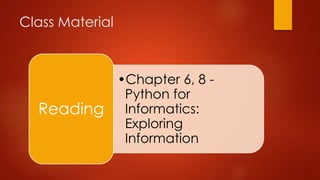
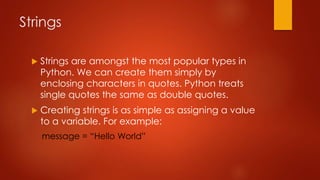
![Introduction to Indexing
Strings can be divided into substrings using indexing.
To access substrings, use the square brackets for slicing along with
the index or indices to obtain your substring, this is called Indexing.
Following is a simple example:
message = 'Hello World!'
messageTwo = "Python Programming"
print "var1[0]: ", message[0]
print "var2[1:5]: ", messageTwo[1:5]](https://image.slidesharecdn.com/introductiontoprogrammingwithpython-lecture3-140927102001-phpapp02/85/Introduction-To-Programming-with-Python-3-5-320.jpg)
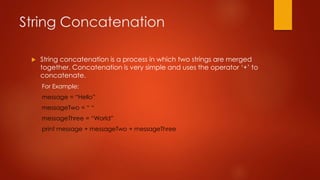
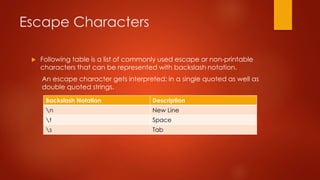

![Python Comparison Operators
[]
• Slice - Gives the character from the given index
[ : ]
•Range Slice - Gives the characters from the
given range](https://image.slidesharecdn.com/introductiontoprogrammingwithpython-lecture3-140927102001-phpapp02/85/Introduction-To-Programming-with-Python-3-9-320.jpg)

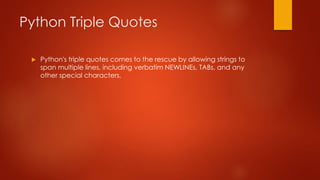

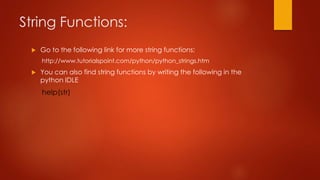
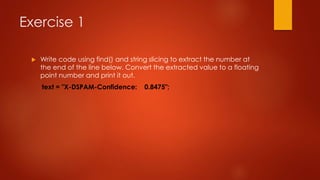
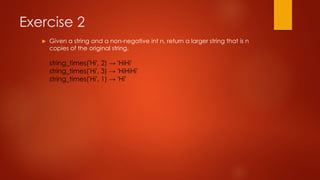
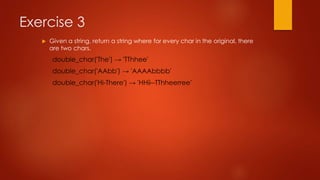

Ad
Recommended
Introduction To Programming with Python-4



Introduction To Programming with Python-4Syed Farjad Zia Zaidi This document provides an introduction to using lists in Python. It defines what lists are in Python, how to create, access, update, and delete list elements, and some common list operations. It also provides examples of creating lists, accessing values at different indices, updating and deleting elements, and using basic operators like addition and multiplication. Finally, it proposes three exercises involving lists to practice these concepts.
Introduction To Programming with Python-1



Introduction To Programming with Python-1Syed Farjad Zia Zaidi Slides for Lecture 1 of the course: Introduction to Programming with Python offered at ICCBS.
It covers the following topics:
1.) Variables, Statements and Expressions
2.) Functions
3.) Flow Control
Python second ppt



Python second pptRaginiJain21 In this PPT you learn some basic terminology and basic concept of Python which is a pillar of python programming.So learn Python programming by these PPT.
You get a new presentation every Sunday at 10 AM.
Chapter 9 python fundamentals



Chapter 9 python fundamentalsPraveen M Jigajinni This document provides an introduction to Python fundamentals, including:
1. The Python character set includes letters, digits, symbols, and whitespace. Individual elements are called tokens or lexical units.
2. Keywords, identifiers, literals, operators, and punctuators are the main types of tokens. Identifiers follow specific naming conventions. Literals include strings, numbers, Booleans, None, and collections.
3. Strings can be single or multi-line with escape sequences. Numbers can be integers, floats, or complex. True, False, and None are Boolean and special literals.
Python 3 Programming Language



Python 3 Programming LanguageTahani Al-Manie This presentation covers tho following topics of Python:
Python Overview
Python Data Types
Python Control Structures
Python Input\output
Python Functions
Python File Handling
Python Exception Handling
Python Modules
Python Classes
Python vs. Java Examples
Python Useful Tools
Who uses Python?
11 Unit 1 Chapter 02 Python Fundamentals



11 Unit 1 Chapter 02 Python FundamentalsPraveen M Jigajinni This document provides an introduction to Python fundamentals. It discusses Python's character set, tokens or lexical units including keywords, identifiers, literals, operators, and punctuators. It also covers Python programming concepts such as variables and assignments, functions, comments, statements, and programming conventions regarding whitespace, maximum line length, and case sensitivity. The document aims to explain the basic building blocks of the Python language to learn Python programming.
Python revision tour i



Python revision tour iMr. Vikram Singh Slathia Computer Science with Python
Class XII
Unit I: Computational Thinking and Programming -2
Chapter 1: Review of Python basics I (Revision Tour Class XI)
Introduction To Programming with Python



Introduction To Programming with PythonSushant Mane The document provides an introduction to the Python programming language. It discusses Python's core features like being an interpreted, object-oriented, and dynamic language. It covers basic Python concepts like data types, variables, operators, control flow, functions, modules, file handling, and object-oriented programming. The document contains examples and explanations of built-in types like numbers, strings, lists, tuples, and dictionaries. It also discusses control structures, functions, modules, and classes in Python.
Python-01| Fundamentals



Python-01| FundamentalsMohd Sajjad After the end of lesson you will be able to learn Python basics-What Python is? Its releases. Where we can use Python? Python Features. Tokens, comments variables etc... In out next PPT you will learn how to input and get output in Python
Chapter 10 data handling



Chapter 10 data handlingPraveen M Jigajinni This document discusses Python data types and handling data in Python. It covers the different types of numbers in Python including integers, floating point numbers, and complex numbers. It also discusses Boolean, string, and tuple data types. Methods for accessing and slicing strings are provided along with examples. Mutable and immutable objects are defined, with lists and tuples given as examples. Operator precedence in Python is also discussed.
Programming with Python



Programming with PythonRasan Samarasinghe Programming with Python - Delivered along with Certificate in C/C++ Programming - ESOFT Metro Campus
(Template - Virtusa Corporate)
Python-04| Fundamental data types vs immutability



Python-04| Fundamental data types vs immutabilityMohd Sajjad Fundamental data types like integers, floats, booleans and strings are immutable in Python. Immutable means the object cannot be changed once created. For integers from 0 to 256, Python reuses the same integer objects to save memory. It also reuses the two boolean objects for True and False. For strings, a new object is created each time due to the large number of possible string values. Floats and complexes are also immutable and do not reuse objects. Immutability helps improve performance and memory usage in Python.
Python revision tour II



Python revision tour IIMr. Vikram Singh Slathia This Slide is based on the Revision of Python you learnt in class 11.
Topic Coverd in this slide are:
Tuble
List
String
Dictionary
Sorting
Lesson 03 python statement, indentation and comments



Lesson 03 python statement, indentation and commentsNilimesh Halder Introduction to Python Programming Language - Learn by End-to-End Examples
Find more at https://setscholars.net
Introduction to Python programming Language



Introduction to Python programming LanguageMansiSuthar3 Python is a popular, high-level programming language that is used for a variety of tasks including web development, machine learning, and data science. It has a simple syntax and is readable. Python has built-in data types like integers, floats, booleans, strings, lists, tuples, and dictionaries. It also supports object-oriented programming. Common operations in Python include conditional statements, loops, functions, packages, file handling, classes, and data visualization using libraries like NumPy, Matplotlib, and Seaborn.
Python cheat-sheet



Python cheat-sheetsrinivasanr281952 This document provides a cheat sheet for Python basics. It begins with an introduction to Python and its advantages. It then covers key Python data types like strings, integers, floats, lists, tuples, and dictionaries. It explains how to define variables, functions, conditional statements, and loops. The document also demonstrates built-in functions, methods for manipulating common data structures, and other Python programming concepts in a concise and easy to understand manner.
Lesson 02 python keywords and identifiers



Lesson 02 python keywords and identifiersNilimesh Halder Introduction to Python Programming Language - Learn by End-to-End Examples.
Week 01 - Python Introduction
WACAMLDS - https://wacamlds.com.au
Introduction to Python 



Introduction to Python amiable_indian The document provides an introduction to Python programming. It discusses installing and running Python, basic Python syntax like variables, data types, conditionals, and functions. It emphasizes that Python uses references rather than copying values, so assigning one variable to another causes both to refer to the same object.
Python



PythonRural Engineering College Hulkoti This Presentation Helps for the beginners to understand easily Python Programming Language, because i had given an snapshot of each concepts. Those who are knowing C,C++ and Java they can easily understand my presentation.
Python Data Types



Python Data Typesathithanvijay This document provides an introduction to the Python programming language. It discusses Python language elements like literals, keywords, identifiers, operators, expressions, statements, and comments. It also covers Python data types, variables, printing values, and how to write and run a simple Python program. The document aims to explain Python concepts in a step-by-step manner to help readers learn the basics of the Python language.
Python Tutorial Part 1



Python Tutorial Part 1Haitham El-Ghareeb This document provides an agenda and overview for a Python tutorial presented over multiple sessions. The first session introduces Python and demonstrates how to use the Python interpreter. The second session covers basic Python data structures like lists, modules, input/output, and exceptions. An optional third session discusses unit testing. The document explains that Python is an easy to learn yet powerful programming language that supports object-oriented programming and high-level data structures in an interpreted, dynamic environment.
Data types in python



Data types in pythonLearnbay Datascience This presentation guide you through the data types in python, numeric data types and its components integer, float and complex.
Fundamentals of Python Programming



Fundamentals of Python ProgrammingKamal Acharya The document provides an introduction to Python programming including its features, uses, history, and installation process. Some key points covered include:
- Python is an interpreted, object-oriented programming language that is used for web development, scientific computing, and desktop applications.
- It was created by Guido van Rossum in 1991 and named after the Monty Python comedy group.
- To install Python on Windows, users download the latest version from python.org and run the installer, which also installs the IDLE development environment.
- The document then covers basic Python concepts like variables, data types, operators, and input/output functions.
Intro to Python Programming Language



Intro to Python Programming LanguageDipankar Achinta Provides an introductory level understanding of the Python Programming Language and language features. Serves as a guide for beginners and a reference to Python basics and language use cases.
Introduction to Python Part-1



Introduction to Python Part-1Devashish Kumar First in the series of slides for python programming, covering topics like programming language, python programming constructs, loops and control statements.
Values and Data types in python



Values and Data types in pythonJothi Thilaga P This document discusses values, data types, and the five standard data types in Python. It defines that values are the fundamental things like numbers and strings that programs manipulate. Data type refers to the type and size of data that variables can hold. The five main data types in Python are numbers, strings, lists, tuples, and dictionaries. Numbers include integers, floating point values, and complex numbers. Lists and tuples are ordered sequences that can hold heterogeneous data, but lists are mutable while tuples are immutable. Strings are ordered sequences of characters. Dictionaries are unordered collections of key-value pairs.
Python basics



Python basicsManisha Gholve The document provides an overview of the Python programming language. It discusses what Python is, its history and naming, features like being dynamically typed and interpreted, popular applications like web development, machine learning, and its architecture. It also covers Python constructs like variables, data types, operators, and strings. The document compares Python to other languages and provides examples of common Python concepts.
Substituting HDF5 tools with Python/H5py scripts



Substituting HDF5 tools with Python/H5py scriptsThe HDF-EOS Tools and Information Center A brief overview of using HDF5 with Python and Andrew Collette's h5py module will be presented, including examples which show how and why Python can be used in the place of HDF5 tools. Extensions to the HDF5 API will be proposed which would further improve the utility of Python/h5py.
Logic Over Language



Logic Over LanguagePurple, Rock, Scissors Understand programming through a pseudo-code example with PRPL Senior Engineer Renee Blunt. Accompanies video found here: https://youtu.be/RHrLGJP7AmI
Python and HDF5: Overview



Python and HDF5: Overviewandrewcollette From a talk by Andrew Collette to the Boulder Earth and Space Science Informatics Group (BESSIG) on November 20, 2013.
This talk explores how researchers can use the scalable, self-describing HDF5 data format together with the Python programming language to improve the analysis pipeline, easily archive and share large datasets, and improve confidence in scientific results. The discussion will focus on real-world applications of HDF5 in experimental physics at two multimillion-dollar research facilities: the Large Plasma Device at UCLA, and the NASA-funded hypervelocity dust accelerator at CU Boulder. This event coincides with the launch of a new O’Reilly book, Python and HDF5: Unlocking Scientific Data.
As scientific datasets grow from gigabytes to terabytes and beyond, the use of standard formats for data storage and communication becomes critical. HDF5, the most recent version of the Hierarchical Data Format originally developed at the National Center for Supercomputing Applications (NCSA), has rapidly emerged as the mechanism of choice for storing and sharing large datasets. At the same time, many researchers who routinely deal with large numerical datasets have been drawn to the Python by its ease of use and rapid development capabilities.
Over the past several years, Python has emerged as a credible alternative to scientific analysis environments like IDL or MATLAB. In addition to stable core packages for handling numerical arrays, analysis, and plotting, the Python ecosystem provides a huge selection of more specialized software, reducing the amount of work necessary to write scientific code while also increasing the quality of results. Python’s excellent support for standard data formats allows scientists to interact seamlessly with colleagues using other platforms.
More Related Content
What's hot (19)
Python-01| Fundamentals



Python-01| FundamentalsMohd Sajjad After the end of lesson you will be able to learn Python basics-What Python is? Its releases. Where we can use Python? Python Features. Tokens, comments variables etc... In out next PPT you will learn how to input and get output in Python
Chapter 10 data handling



Chapter 10 data handlingPraveen M Jigajinni This document discusses Python data types and handling data in Python. It covers the different types of numbers in Python including integers, floating point numbers, and complex numbers. It also discusses Boolean, string, and tuple data types. Methods for accessing and slicing strings are provided along with examples. Mutable and immutable objects are defined, with lists and tuples given as examples. Operator precedence in Python is also discussed.
Programming with Python



Programming with PythonRasan Samarasinghe Programming with Python - Delivered along with Certificate in C/C++ Programming - ESOFT Metro Campus
(Template - Virtusa Corporate)
Python-04| Fundamental data types vs immutability



Python-04| Fundamental data types vs immutabilityMohd Sajjad Fundamental data types like integers, floats, booleans and strings are immutable in Python. Immutable means the object cannot be changed once created. For integers from 0 to 256, Python reuses the same integer objects to save memory. It also reuses the two boolean objects for True and False. For strings, a new object is created each time due to the large number of possible string values. Floats and complexes are also immutable and do not reuse objects. Immutability helps improve performance and memory usage in Python.
Python revision tour II



Python revision tour IIMr. Vikram Singh Slathia This Slide is based on the Revision of Python you learnt in class 11.
Topic Coverd in this slide are:
Tuble
List
String
Dictionary
Sorting
Lesson 03 python statement, indentation and comments



Lesson 03 python statement, indentation and commentsNilimesh Halder Introduction to Python Programming Language - Learn by End-to-End Examples
Find more at https://setscholars.net
Introduction to Python programming Language



Introduction to Python programming LanguageMansiSuthar3 Python is a popular, high-level programming language that is used for a variety of tasks including web development, machine learning, and data science. It has a simple syntax and is readable. Python has built-in data types like integers, floats, booleans, strings, lists, tuples, and dictionaries. It also supports object-oriented programming. Common operations in Python include conditional statements, loops, functions, packages, file handling, classes, and data visualization using libraries like NumPy, Matplotlib, and Seaborn.
Python cheat-sheet



Python cheat-sheetsrinivasanr281952 This document provides a cheat sheet for Python basics. It begins with an introduction to Python and its advantages. It then covers key Python data types like strings, integers, floats, lists, tuples, and dictionaries. It explains how to define variables, functions, conditional statements, and loops. The document also demonstrates built-in functions, methods for manipulating common data structures, and other Python programming concepts in a concise and easy to understand manner.
Lesson 02 python keywords and identifiers



Lesson 02 python keywords and identifiersNilimesh Halder Introduction to Python Programming Language - Learn by End-to-End Examples.
Week 01 - Python Introduction
WACAMLDS - https://wacamlds.com.au
Introduction to Python 



Introduction to Python amiable_indian The document provides an introduction to Python programming. It discusses installing and running Python, basic Python syntax like variables, data types, conditionals, and functions. It emphasizes that Python uses references rather than copying values, so assigning one variable to another causes both to refer to the same object.
Python



PythonRural Engineering College Hulkoti This Presentation Helps for the beginners to understand easily Python Programming Language, because i had given an snapshot of each concepts. Those who are knowing C,C++ and Java they can easily understand my presentation.
Python Data Types



Python Data Typesathithanvijay This document provides an introduction to the Python programming language. It discusses Python language elements like literals, keywords, identifiers, operators, expressions, statements, and comments. It also covers Python data types, variables, printing values, and how to write and run a simple Python program. The document aims to explain Python concepts in a step-by-step manner to help readers learn the basics of the Python language.
Python Tutorial Part 1



Python Tutorial Part 1Haitham El-Ghareeb This document provides an agenda and overview for a Python tutorial presented over multiple sessions. The first session introduces Python and demonstrates how to use the Python interpreter. The second session covers basic Python data structures like lists, modules, input/output, and exceptions. An optional third session discusses unit testing. The document explains that Python is an easy to learn yet powerful programming language that supports object-oriented programming and high-level data structures in an interpreted, dynamic environment.
Data types in python



Data types in pythonLearnbay Datascience This presentation guide you through the data types in python, numeric data types and its components integer, float and complex.
Fundamentals of Python Programming



Fundamentals of Python ProgrammingKamal Acharya The document provides an introduction to Python programming including its features, uses, history, and installation process. Some key points covered include:
- Python is an interpreted, object-oriented programming language that is used for web development, scientific computing, and desktop applications.
- It was created by Guido van Rossum in 1991 and named after the Monty Python comedy group.
- To install Python on Windows, users download the latest version from python.org and run the installer, which also installs the IDLE development environment.
- The document then covers basic Python concepts like variables, data types, operators, and input/output functions.
Intro to Python Programming Language



Intro to Python Programming LanguageDipankar Achinta Provides an introductory level understanding of the Python Programming Language and language features. Serves as a guide for beginners and a reference to Python basics and language use cases.
Introduction to Python Part-1



Introduction to Python Part-1Devashish Kumar First in the series of slides for python programming, covering topics like programming language, python programming constructs, loops and control statements.
Values and Data types in python



Values and Data types in pythonJothi Thilaga P This document discusses values, data types, and the five standard data types in Python. It defines that values are the fundamental things like numbers and strings that programs manipulate. Data type refers to the type and size of data that variables can hold. The five main data types in Python are numbers, strings, lists, tuples, and dictionaries. Numbers include integers, floating point values, and complex numbers. Lists and tuples are ordered sequences that can hold heterogeneous data, but lists are mutable while tuples are immutable. Strings are ordered sequences of characters. Dictionaries are unordered collections of key-value pairs.
Python basics



Python basicsManisha Gholve The document provides an overview of the Python programming language. It discusses what Python is, its history and naming, features like being dynamically typed and interpreted, popular applications like web development, machine learning, and its architecture. It also covers Python constructs like variables, data types, operators, and strings. The document compares Python to other languages and provides examples of common Python concepts.
Viewers also liked (20)
Substituting HDF5 tools with Python/H5py scripts



Substituting HDF5 tools with Python/H5py scriptsThe HDF-EOS Tools and Information Center A brief overview of using HDF5 with Python and Andrew Collette's h5py module will be presented, including examples which show how and why Python can be used in the place of HDF5 tools. Extensions to the HDF5 API will be proposed which would further improve the utility of Python/h5py.
Logic Over Language



Logic Over LanguagePurple, Rock, Scissors Understand programming through a pseudo-code example with PRPL Senior Engineer Renee Blunt. Accompanies video found here: https://youtu.be/RHrLGJP7AmI
Python and HDF5: Overview



Python and HDF5: Overviewandrewcollette From a talk by Andrew Collette to the Boulder Earth and Space Science Informatics Group (BESSIG) on November 20, 2013.
This talk explores how researchers can use the scalable, self-describing HDF5 data format together with the Python programming language to improve the analysis pipeline, easily archive and share large datasets, and improve confidence in scientific results. The discussion will focus on real-world applications of HDF5 in experimental physics at two multimillion-dollar research facilities: the Large Plasma Device at UCLA, and the NASA-funded hypervelocity dust accelerator at CU Boulder. This event coincides with the launch of a new O’Reilly book, Python and HDF5: Unlocking Scientific Data.
As scientific datasets grow from gigabytes to terabytes and beyond, the use of standard formats for data storage and communication becomes critical. HDF5, the most recent version of the Hierarchical Data Format originally developed at the National Center for Supercomputing Applications (NCSA), has rapidly emerged as the mechanism of choice for storing and sharing large datasets. At the same time, many researchers who routinely deal with large numerical datasets have been drawn to the Python by its ease of use and rapid development capabilities.
Over the past several years, Python has emerged as a credible alternative to scientific analysis environments like IDL or MATLAB. In addition to stable core packages for handling numerical arrays, analysis, and plotting, the Python ecosystem provides a huge selection of more specialized software, reducing the amount of work necessary to write scientific code while also increasing the quality of results. Python’s excellent support for standard data formats allows scientists to interact seamlessly with colleagues using other platforms.
Introduction To Programming with Python-5



Introduction To Programming with Python-5Syed Farjad Zia Zaidi Slides for Lecture 5 of the course: Introduction to Programming with Python offered at ICCBS.
It covers the following topics:
1.)Python Modules
2.)File I/O
3.)Exceptions & Error Handling
Introduction to Databases



Introduction to DatabasesSyed Farjad Zia Zaidi This document is a Stanford Online Statement of Accomplishment certifying that Syed Farjad Zia Zaidi successfully completed with distinction an online Introduction to Databases course offered through OpenEdX. However, it does not confer any Stanford University course credit, grade, or degree and only verifies completion, not the student's identity.
An Introduction to Interactive Programming in Python 2013



An Introduction to Interactive Programming in Python 2013Syed Farjad Zia Zaidi My Verified Certificate for An Introduction to Interactive Programming in Python 2013 by Rice University and offered through Coursera
Logic: Language and Information 1



Logic: Language and Information 1Syed Farjad Zia Zaidi My Verified Certificate for Logic: Language and Information 1 by The University of Melbourne and offered through Coursera.
Introduction to UBI



Introduction to UBIRoy Lee This document describes UBI (Unsorted Block Images), a volume management system for flash devices in Linux. It provides static and dynamic volumes, wear-leveling across the entire flash device, bad block management, and read disturbance handling. The key components of UBI are the kernel API, EBA (Erase Block Association) subsystem, wear-leveling subsystem, and scanning subsystem. The wear-leveling subsystem manages PEBs (Physical Erase Blocks) using RB-trees and a queue to perform wear leveling and scrubbing.
Python 4 Arc



Python 4 Arcabsvis This document provides an overview of using Python and the Geoprocessor object to automate geoprocessing tasks in ArcGIS. It discusses:
1) Converting multiple ASCII files to rasters, merging the rasters, reclassifying the data, and converting it to polygon and polyline shapefiles involves many manual steps.
2) Scripting can automate this repetitive process and save time compared to performing the tasks manually each time.
3) The Geoprocessor object in ArcGIS provides a single access point to the toolbox and its methods/properties can be used to programmatically run geoprocessing tools from Python scripts.
The Python Programming Language and HDF5: H5Py



The Python Programming Language and HDF5: H5PyThe HDF-EOS Tools and Information Center An introduction to the Python programming language and its numerical abilities will be presented. With this background, Andrew Collette's H5Py module--an HDF5-Python interface--will be explained highlighting the unique and useful similarities between Python data structures and HDF5.
Clase 2 estatica 



Clase 2 estatica Gerald Moreira Ramírez La mecánica es la ciencia que estudia el movimiento y reposo de los cuerpos bajo la acción de fuerzas. Se divide en mecánica de cuerpos rígidos, deformables y fluidos. La mecánica de cuerpos rígidos se subdivide en estática, que estudia cuerpos en reposo, y dinámica, que estudia cuerpos en movimiento. La mecánica se remonta a Aristóteles y Newton y utiliza conceptos como fuerza, masa, espacio y tiempo.
Using HDF5 and Python: The H5py module



Using HDF5 and Python: The H5py moduleThe HDF-EOS Tools and Information Center This document discusses using Python with the H5py module to interact with HDF5 files. Some key points made include:
- H5py allows HDF5 files to be manipulated as if they were Python dictionaries, with dataset names as keys and arrays as values.
- NumPy provides array manipulation capabilities to work with the dataset values retrieved from HDF5 files.
- Examples demonstrate reading and writing HDF5 datasets, comparing contents of datasets between files, and recursively listing contents of an HDF5 file.
- Using Python with H5py is more concise than other languages like C/Fortran, reducing development time and potential for errors.
HDF5 Tools



HDF5 ToolsThe HDF-EOS Tools and Information Center This tutorial is designed for anyone who needs to work with data stored in HDF5 files. The tutorial will cover functionality and useful features of the HDF5 utilities h5dump, h5diff, h5repack, h5stat, h5copy, h5check and h5repart. We will also introduce a prototype of the new h52jpeg conversion tool and recently released h5perf_serial tool used for performance studies. We will briefly introduce HDFView. Details of the HDFView and HDF-Java will be discussed in a separate tutorial.
Python programming - Everyday(ish) Examples



Python programming - Everyday(ish) ExamplesAshish Sharma Learn about how to use the Python language and its constructs in different situations. With classification of scenarios done already you can use this material as a reference guide too.
Learn the language and its idioms by trying out the sample code or by looking at code snippet.
This presentation was created for Next Craft JMP Student Program to help students jump start with Python programming.
Lets learn Python !



Lets learn Python !Kiran Gangadharan This document provides an introduction to the Python programming language. It discusses why Python is a good language to learn, as it is readable, powerful, productive, portable, and can be used for web development, data analysis, and more. Major companies and organizations like Google, YouTube, and NASA use Python. The creator of Python was Guido Van Rossum. The document concludes by inviting the reader to learn Python basics like Hello World, variables, control flow, and data structures.
Introduction To Programming with Python Lecture 2



Introduction To Programming with Python Lecture 2Syed Farjad Zia Zaidi Slides for Lecture 2 of the course: Introduction to Programming with Python offered at ICCBS.
It covers the following topics:
Flow Control
Cyberoam Firewall Presentation



Cyberoam Firewall PresentationManoj Kumar Mishra Cyberoam UTM appliances enables small offices to shift from plain firewall to comprehensive UTM protection with cost effective, which gives powerful security to protect your network from malware, spam, trojan, DoS, DDoS, Phishing, pharming and intrusions. Large organizations can implement uniform security and gain high visibility into remote and branch offices with centralized management and Layer 8 Identity-based security.
introduction to python



introduction to pythonSardar Alam This document provides an introduction to Python programming for an artificial intelligence lab course. It covers downloading and installing Python and the Anaconda distribution, using Spyder as an IDE, variables and data types in Python, and basic concepts like indentation, variable naming conventions, and Python keywords. The goal is to prepare students to use Python for labs related to artificial intelligence topics.
Ad
Similar to Introduction To Programming with Python-3 (20)
python_strings.pdf



python_strings.pdfrajendraprasadbabub1 This document provides an overview of strings in Python. It discusses how to create, access, update, and format strings. Various string methods and operators are also described, including slicing, concatenation, formatting, escaping characters, and more. Built-in string methods allow manipulation of strings through actions like capitalization, padding, stripping, counting occurrences, and other processing of string values.
Python data handling



Python data handlingProf. Dr. K. Adisesha • List is a collection, which is ordered and changeable. Allows duplicate members.
• Tuple is a collection, which is ordered and unchangeable. Allows duplicate members.
• Set is a collection, which is unordered and unindexed. No duplicate members.
• Dictionary is a collection, which is unordered, changeable and indexed. No duplicate members.
: String, List, Tuple, Dictionary
• List is a collection, which is ordered and changeable. Allows duplicate members.
• Tuple is a collection, which is ordered and unchangeable. Allows duplicate members.
• Set is a collection, which is unordered and unindexed. No duplicate members.
• Dictionary is a collection, which is unordered, changeable and indexed. No duplicate members.
Python Programming-UNIT-II - Strings.pptx



Python Programming-UNIT-II - Strings.pptxKavithaDonepudi This is programming in python using strings
Strings in Python



Strings in Pythonnitamhaske This document provides an introduction and overview of strings in Python. It discusses that strings are a data type that can contain sequences of characters. The built-in string class is 'str' and strings can be defined using single, double, or triple quotes. Strings support various methods like indexing, slicing, concatenation, formatting and more. Common string methods are also described such as upper(), lower(), split(), join() which allow manipulating strings. The document also discusses comparing and slicing strings in Python.
string manipulation in python ppt for grade 11 cbse



string manipulation in python ppt for grade 11 cbseKrithikaTM String Manipulation in python which will cover string traversal ,
It means accessing the individual characters of string i.e. from first character to last character.
Every character in string is at different index position i.e. from 0 to size-1
For loop can be used to traverse the string very easily
string functions, indexing, slicing, membership operation
Python String Revisited.pptx



Python String Revisited.pptxChandrapriya Jayabal This document discusses Python string data types and operations. Some key points covered include:
- Strings can be defined using single quotes or double quotes and support indexing, slicing, and string operations like concatenation and comparison.
- Common string methods allow searching, modifying, and analyzing string content through functions like find(), lower(), strip(), and replace().
- Strings can be looped through to access individual characters using a for loop or while loop with indexing.
- The len() function returns the length of a string and special string values like -1 are returned when substrings are not found during searches.
Lexture about strings, all examples and theoretical part is included



Lexture about strings, all examples and theoretical part is includedabzalbekulasbekov Lecture is about strings
UNIT 4 python.pptx



UNIT 4 python.pptxTKSanthoshRao bbbbbbbbbbbbbbbbbbbbbbbbbbbbbbbbbbbbbbbbbbbbbbbbbbbbbbbbbbbbbbbbbbbbbbbbbbbbbbbbbbbbbbbbbbbbbbbbbbbbbbbbbbbbbbbbbbbbb
STRINGS IN PYTHON



STRINGS IN PYTHONTanushTM1 This group presentation covers strings in Python. It defines strings as collections of characters that can be manipulated and formatted. The presentation discusses how to create, index, slice, concatenate and format strings. It also covers escape characters and built-in string methods for operations like capitalization, counting characters, and splitting strings. The presentation provides examples to illustrate string concepts in Python.
Strings.pptx



Strings.pptxYagna15 A string is a sequence of characters that can be accessed individually using indexes. Strings are immutable, so their characters cannot be changed, only new strings can be reassigned or created. Common string methods include upper()/lower() to convert case, split() to separate a string into a list by a delimiter, join() to combine a list into a string, replace() to substitute characters, and find() to locate a substring.
PPS_Unit 4.ppt



PPS_Unit 4.pptKundanBhatkar The document discusses strings and string operations in Python. It defines what a string is, how they are defined and different ways to manipulate strings like concatenation, slicing, formatting, built-in methods etc. It also discusses various string methods like capitalize(), lower(), upper(), count(), find(), format() etc and functions like ord(), chr() to work with strings.
Python course



Python courseЕвгений Сазонов This document provides an overview and instructions for a course in Python programming. It discusses the recommended course literature, including Learning Python and Python in a Nutshell books. It also describes using the IDLE integrated development environment for writing and running Python code on Windows and Unix systems. The document then begins covering basic Python concepts like variables, data types, strings, lists, dictionaries and objects.
trisha comp ppt.pptx



trisha comp ppt.pptxTapaswini14 This document discusses strings in Python. It begins by defining strings as sequences of characters that can be represented using single or double quotes. It then discusses some key reasons why strings are important in programming, including text representation, input/output handling, and text processing. It also covers string literals, operations like repetition, membership, slicing, and concatenation. Finally, it discusses some real-world applications of strings like spell checkers, search engines, and information retrieval systems.
Ad
More from Syed Farjad Zia Zaidi (20)
Vision & sight



Vision & sightSyed Farjad Zia Zaidi The document discusses the difference between sight and vision. Sight is limited to what the eyes can see, while vision is unlimited by the imagination and looks to the future. True visionary leadership comes from pursuing a noble vision that inspires others to submit their energies and skills towards achieving that vision through the leader's character and influence. The source of all vision ultimately comes from God, who imparted purpose and reason for creation.
Introduction to Computing with Java



Introduction to Computing with JavaSyed Farjad Zia Zaidi My Honor Code Certificate for COMP102x: Introduction to Computing with Java offered by The Hong Kong University of Science and Technology through edX.
Web Application Architectures



Web Application ArchitecturesSyed Farjad Zia Zaidi My Statement of Accomplishment for Web Application Architectures offered by University of New Mexico through Coursera.
Foundations of Virtual Instruction



Foundations of Virtual InstructionSyed Farjad Zia Zaidi My Verified Certificate for Foundations of Virtual Instruction by University of California, Irvine and offered through Coursera.
Programming for Everybody (Python)



Programming for Everybody (Python)Syed Farjad Zia Zaidi My Verified Certificate for Programming for Everybody (Python) by University of Michigan and offered through Coursera.
Learn to Program: The Fundamentals



Learn to Program: The FundamentalsSyed Farjad Zia Zaidi My Statement of Accomplishment for Learn to Program: The Fundamentals by University of Toronto's and offered through Coursera.
Introduction to Systematic Program Design - Part 1



Introduction to Systematic Program Design - Part 1Syed Farjad Zia Zaidi My Statement of Accomplishment for Introduction to Systematic Program Design - Part 1 by The University of British Columbia and offered through Coursera.
Emerging Trends & Technologies in the Virtual K-12 Classroom



Emerging Trends & Technologies in the Virtual K-12 ClassroomSyed Farjad Zia Zaidi Syed Farjad Zia Zaidi completed a 5 week online course on emerging trends and technologies in virtual K-12 classrooms through Coursera with distinction. The course was authorized by University of California, Irvine and Syed's identity and participation in the course was verified by Coursera.
An Introduction to Interactive Programming in Python 2014



An Introduction to Interactive Programming in Python 2014Syed Farjad Zia Zaidi My Statement of Accomplishment for An Introduction to Interactive Programming in Python 2014 by Rice University and offered through Coursera
Internet History, Technology, and Security



Internet History, Technology, and SecuritySyed Farjad Zia Zaidi My Verified Certificate for Internet History, Technology, and Security offered by University of Michigan and offered through Coursera
Human-Computer Interaction



Human-Computer InteractionSyed Farjad Zia Zaidi My Statement of Accomplishment for Human-Computer Interaction offered by The University of California, San Diego's and offered through Coursera
Beginning Game Programming with C#



Beginning Game Programming with C#Syed Farjad Zia Zaidi This document is a Statement of Accomplishment from Coursera.org dated November 13, 2013 for Syed Farjad Zia Zaidi who completed the introductory course "Beginning Game Programming with C#" taught by Tim "Dr. T" Chamillard, an Associate Professor of Computer Science and Program Director for the Bachelor of Innovation in Game Design and Development at the University of Colorado Colorado Springs. The course teaches beginning programming concepts in the context of game development.
Programming Mobile Applications for Android Handheld Systems 2014



Programming Mobile Applications for Android Handheld Systems 2014Syed Farjad Zia Zaidi My Verified Certificate for Programming Mobile Applications for Android Handheld Systems 2014 offered by University of Maryland, College Park and offered through Coursera
Computer Science 101



Computer Science 101Syed Farjad Zia Zaidi This document certifies that Syed Farjad Zia Zaidi successfully completed the free online course Computer Science 101 provided by Stanford University. It notes that the online course is not equivalent to an on-campus course and does not confer any Stanford University credits, grades, or degrees. The statement also cautions that it does not verify the identity of the student.
Software Requirement Specification - Software Pack Solution 14



Software Requirement Specification - Software Pack Solution 14Syed Farjad Zia Zaidi This document is a software requirements specification for a custom installer called "Software Pack Solution 14" created by Syed Farjad Zia Zaidi. The installer will allow users to install and uninstall common software packages with a single click, saving technicians time. It will display brief system information and install selected software silently using default settings. The document outlines functional requirements for installation and uninstallation, as well as performance goals, system requirements, and provides data flow diagrams to illustrate the installation process.
Project Proposal - Software Pack Solution 14



Project Proposal - Software Pack Solution 14Syed Farjad Zia Zaidi This document proposes a custom installer software project. The software will automatically install common software applications like web browsers, anti-virus software, and media players with default settings to save technicians and home users time during the installation process. It will have a simple user interface and install selections quickly while allowing the user to do other tasks. The project will be developed using C# and .NET frameworks in Visual Studio. It aims to benefit computer repair shops and technicians by reducing the time spent installing software on computers as well as help home users avoid lengthy manual installations.
Database Diagram Tutorial-SQL Server 2012



Database Diagram Tutorial-SQL Server 2012Syed Farjad Zia Zaidi This document provides instructions for creating a database diagram in Microsoft SQL Server Management Studio. It outlines opening an existing project, expanding the database tree, right clicking on "Database Diagrams" and selecting "New Database Diagram" to start a new diagram. From there, it describes selecting tables to add to the diagram, copying the diagram to the clipboard, and pasting into paint to save it.
MindMuscle Xtreme



MindMuscle XtremeSyed Farjad Zia Zaidi This document presents the requirements for a gym management software system called MindMuscle-Xtreme. It provides an overview of the purpose and scope, which is to design a user-friendly system to efficiently manage all aspects of running a gym. The document describes high-level requirements including user interfaces, database and system requirements. It also provides details on the proposed system design, including entity relationship diagrams, data flow diagrams and screenshots of example interfaces.
How to connect database file to a 3-Tier Architecture Application and obtain ...



How to connect database file to a 3-Tier Architecture Application and obtain ...Syed Farjad Zia Zaidi This is a tutorial for connecting the database file to a 3 Layer Architecture Project and obtain the connection string on the run time so that you can deploy your project
Level 1 DFD



Level 1 DFDSyed Farjad Zia Zaidi This document outlines the key administrative functions of a gym owner including managing member, employee, and instructor accounts and data; setting and collecting fees from members; paying salaries to employees and instructors; selling supplements and medicines; overseeing training programs; and handling finances like expenses, salaries, and fees. The owner is responsible for the overall management and operations of the gym.
How to connect database file to a 3-Tier Architecture Application and obtain ...



How to connect database file to a 3-Tier Architecture Application and obtain ...Syed Farjad Zia Zaidi
Recently uploaded (20)
Software Engineering Process, Notation & Tools Introduction - Part 4



Software Engineering Process, Notation & Tools Introduction - Part 4Gaurav Sharma Software Engineering Process, Notation & Tools Introduction
How Insurance Policy Administration Streamlines Policy Lifecycle for Agile Op...



How Insurance Policy Administration Streamlines Policy Lifecycle for Agile Op...Insurance Tech Services A modern Policy Administration System streamlines workflows and integrates with core systems to boost speed, accuracy, and customer satisfaction across the policy lifecycle. Visit https://www.damcogroup.com/insurance/policy-administration-systems for more details!
Code and No-Code Journeys: The Coverage Overlook



Code and No-Code Journeys: The Coverage OverlookApplitools Explore practical ways to expand visual and functional UI coverage without deep coding or heavy maintenance in this session. Session recording and more info at applitools.com
Integrating Survey123 and R&H Data Using FME



Integrating Survey123 and R&H Data Using FMESafe Software West Virginia Department of Transportation (WVDOT) actively engages in several field data collection initiatives using Collector and Survey 123. A critical component for effective asset management and enhanced analytical capabilities is the integration of Geographic Information System (GIS) data with Linear Referencing System (LRS) data. Currently, RouteID and Measures are not captured in Survey 123. However, we can bridge this gap through FME Flow automation. When a survey is submitted through Survey 123 for ArcGIS Portal (10.8.1), it triggers FME Flow automation. This process uses a customized workbench that interacts with a modified version of Esri's Geometry to Measure API. The result is a JSON response that includes RouteID and Measures, which are then applied to the feature service record.
Porting Qt 5 QML Modules to Qt 6 Webinar



Porting Qt 5 QML Modules to Qt 6 WebinarICS Have you upgraded your application from Qt 5 to Qt 6? If so, your QML modules might still be stuck in the old Qt 5 style—technically compatible, but far from optimal. Qt 6 introduces a modernized approach to QML modules that offers better integration with CMake, enhanced maintainability, and significant productivity gains.
In this webinar, we’ll walk you through the benefits of adopting Qt 6 style QML modules and show you how to make the transition. You'll learn how to leverage the new module system to reduce boilerplate, simplify builds, and modernize your application architecture. Whether you're planning a full migration or just exploring what's new, this session will help you get the most out of your move to Qt 6.
How Insurance Policy Management Software Streamlines Operations



How Insurance Policy Management Software Streamlines OperationsInsurance Tech Services Insurance policy management software transforms complex, manual insurance operations into streamlined, efficient digital workflows, enhancing productivity, accuracy, customer service, and profitability for insurers. Visit https://www.damcogroup.com/insurance/policy-management-software for more details!
From Chaos to Clarity - Designing (AI-Ready) APIs with APIOps Cycles



From Chaos to Clarity - Designing (AI-Ready) APIs with APIOps CyclesMarjukka Niinioja Teams delivering API are challenges with:
- Connecting APIs to business strategy
- Measuring API success (audit & lifecycle metrics)
- Partner/Ecosystem onboarding
- Consistent documentation, security, and publishing
🧠 The big takeaway?
Many teams can build APIs. But few connect them to value, visibility, and long-term improvement.
That’s why the APIOps Cycles method helps teams:
📍 Start where the pain is (one “metro station” at a time)
📈 Scale success across strategy, platform, and operations
🛠 Use collaborative canvases to get buy-in and visibility
Want to try it and learn more?
- Follow APIOps Cycles in LinkedIn
- Visit the www.apiopscycles.com site
- Subscribe to email list
-
Revolutionize Your Insurance Workflow with Claims Management Software



Revolutionize Your Insurance Workflow with Claims Management SoftwareInsurance Tech Services Claims management software enhances efficiency, accuracy, and satisfaction by automating processes, reducing errors, and speeding up transparent claims handling—building trust and cutting costs. Explore More - https://www.damcogroup.com/insurance/claims-management-software
Leveraging Foundation Models to Infer Intents



Leveraging Foundation Models to Infer IntentsKeheliya Gallaba Invited Talk at RAISE 2025: Requirements engineering for AI-powered SoftwarE Workshop co-located with ICSE, the IEEE/ACM International Conference on Software Engineering.
Abstract: Foundation Models (FMs) have shown remarkable capabilities in various natural language tasks. However, their ability to accurately capture stakeholder requirements remains a significant challenge for using FMs for software development. This paper introduces a novel approach that leverages an FM-powered multi-agent system called AlignMind to address this issue. By having a cognitive architecture that enhances FMs with Theory-of-Mind capabilities, our approach considers the mental states and perspectives of software makers. This allows our solution to iteratively clarify the beliefs, desires, and intentions of stakeholders, translating these into a set of refined requirements and a corresponding actionable natural language workflow in the often-overlooked requirements refinement phase of software engineering, which is crucial after initial elicitation. Through a multifaceted evaluation covering 150 diverse use cases, we demonstrate that our approach can accurately capture the intents and requirements of stakeholders, articulating them as both specifications and a step-by-step plan of action. Our findings suggest that the potential for significant improvements in the software development process justifies these investments. Our work lays the groundwork for future innovation in building intent-first development environments, where software makers can seamlessly collaborate with AIs to create software that truly meets their needs.
Automating Map Production With FME and Python



Automating Map Production With FME and PythonSafe Software People still love a good paper map, but every time a request lands on a GIS team’s desk, it takes time to create that perfect, individual map—even when you're ready and have projects prepped. Then come the inevitable changes and iterations that add even more time to the process. This presentation explores a solution for automating map production using FME and Python. FME handles the setup of variables, leveraging GIS reference layers and parameters to manage details like map orientation, label sizes, and layout elements. Python takes over to export PDF maps for each location and template size, uploading them monthly to ArcGIS Online. The result? Fresh, regularly updated maps, ready for anyone to grab anytime—saving you time, effort, and endless revisions while keeping users happy with up-to-date, accessible maps.
14 Years of Developing nCine - An Open Source 2D Game Framework



14 Years of Developing nCine - An Open Source 2D Game FrameworkAngelo Theodorou A 14-year journey developing nCine, an open-source 2D game framework.
This talk covers its origins, the challenges of staying motivated over the long term, and the hurdles of open-sourcing a personal project while working in the game industry.
Along the way, it’s packed with juicy technical pills to whet the appetite of the most curious developers.
Shell Skill Tree - LabEx Certification (LabEx)



Shell Skill Tree - LabEx Certification (LabEx)VICTOR MAESTRE RAMIREZ Shell Skill Tree - LabEx Certification (LabEx)
FME for Climate Data: Turning Big Data into Actionable Insights



FME for Climate Data: Turning Big Data into Actionable InsightsSafe Software Regional and local governments aim to provide essential services for stormwater management systems. However, rapid urbanization and the increasing impacts of climate change are putting growing pressure on these governments to identify stormwater needs and develop effective plans. To address these challenges, GHD developed an FME solution to process over 20 years of rainfall data from rain gauges and USGS radar datasets. This solution extracts, organizes, and analyzes Next Generation Weather Radar (NEXRAD) big data, validates it with other data sources, and produces Intensity Duration Frequency (IDF) curves and future climate projections tailored to local needs. This presentation will showcase how FME can be leveraged to manage big data and prioritize infrastructure investments.
Marketo & Dynamics can be Most Excellent to Each Other – The Sequel



Marketo & Dynamics can be Most Excellent to Each Other – The SequelBradBedford3 So you’ve built trust in your Marketo Engage-Dynamics integration—excellent. But now what?
This sequel picks up where our last adventure left off, offering a step-by-step guide to move from stable sync to strategic power moves. We’ll share real-world project examples that empower sales and marketing to work smarter and stay aligned.
If you’re ready to go beyond the basics and do truly most excellent stuff, this session is your guide.
Key AI Technologies Used by Indian Artificial Intelligence Companies



Key AI Technologies Used by Indian Artificial Intelligence CompaniesMypcot Infotech Indian tech firms are rapidly adopting advanced tools like machine learning, natural language processing, and computer vision to drive innovation. These key AI technologies enable smarter automation, data analysis, and decision-making. Leading developments are shaping the future of digital transformation among top artificial intelligence companies in India.
For more information please visit here https://www.mypcot.com/artificial-intelligence
IBM Rational Unified Process For Software Engineering - Introduction



IBM Rational Unified Process For Software Engineering - IntroductionGaurav Sharma IBM Rational Unified Process For Software Engineering
Plooma is a writing platform to plan, write, and shape books your way



Plooma is a writing platform to plan, write, and shape books your wayPlooma Plooma is your all in one writing companion, designed to support authors at every twist and turn of the book creation journey. Whether you're sketching out your story's blueprint, breathing life into characters, or crafting chapters, Plooma provides a seamless space to organize all your ideas and materials without the overwhelm. Its intuitive interface makes building rich narratives and immersive worlds feel effortless.
Packed with powerful story and character organization tools, Plooma lets you track character development and manage world building details with ease. When it’s time to write, the distraction-free mode offers a clean, minimal environment to help you dive deep and write consistently. Plus, built-in editing tools catch grammar slips and style quirks in real-time, polishing your story so you don’t have to juggle multiple apps.
What really sets Plooma apart is its smart AI assistant - analyzing chapters for continuity, helping you generate character portraits, and flagging inconsistencies to keep your story tight and cohesive. This clever support saves you time and builds confidence, especially during those complex, detail packed projects.
Getting started is simple: outline your story’s structure and key characters with Plooma’s user-friendly planning tools, then write your chapters in the focused editor, using analytics to shape your words. Throughout your journey, Plooma’s AI offers helpful feedback and suggestions, guiding you toward a polished, well-crafted book ready to share with the world.
With Plooma by your side, you get a powerful toolkit that simplifies the creative process, boosts your productivity, and elevates your writing - making the path from idea to finished book smoother, more fun, and totally doable.
Get Started here: https://www.plooma.ink/
Wondershare PDFelement Pro 11.4.20.3548 Crack Free Download



Wondershare PDFelement Pro 11.4.20.3548 Crack Free DownloadPuppy jhon ➡ 🌍📱👉COPY & PASTE LINK👉👉👉 ➤ ➤➤ https://drfiles.net/
Wondershare PDFelement Professional is professional software that can edit PDF files. This digital tool can manipulate elements in PDF documents.
wAIred_RabobankIgniteSession_12062025.pptx



wAIred_RabobankIgniteSession_12062025.pptxSimonedeGijt In today's world, artificial intelligence (AI) is transforming the way we learn.
This talk will explore how we can use AI tools to enhance our learning experiences, by looking at some (recent) research that has been done on the matter.
But as we embrace these new technologies, we must also ask ourselves:
Are we becoming less capable of thinking for ourselves?
Do these tools make us smarter, or do they risk dulling our critical thinking skills?
This talk will encourage us to think critically about the role of AI in our education. Together, we will discover how to use AI to support our learning journey while still developing our ability to think critically.
How Insurance Policy Administration Streamlines Policy Lifecycle for Agile Op...



How Insurance Policy Administration Streamlines Policy Lifecycle for Agile Op...Insurance Tech Services
Introduction To Programming with Python-3
- 1. Introduction to Programming with Python – Class 3 SYED FARJAD ZIA ZAIDI
- 2. Class Objectives Class Objective Understanding Strings and some useful string operations. Write few simple programs that use string functions and lists.
- 3. Class Material •Chapter 6, 8 - Python for Informatics: Exploring Information Reading
- 4. Strings Strings are amongst the most popular types in Python. We can create them simply by enclosing characters in quotes. Python treats single quotes the same as double quotes. Creating strings is as simple as assigning a value to a variable. For example: message = “Hello World”
- 5. Introduction to Indexing Strings can be divided into substrings using indexing. To access substrings, use the square brackets for slicing along with the index or indices to obtain your substring, this is called Indexing. Following is a simple example: message = 'Hello World!' messageTwo = "Python Programming" print "var1[0]: ", message[0] print "var2[1:5]: ", messageTwo[1:5]
- 6. String Concatenation String concatenation is a process in which two strings are merged together. Concatenation is very simple and uses the operator ‘+’ to concatenate. For Example: message = “Hello” messageTwo = “ “ messageThree = “World” print message + messageTwo + messageThree
- 7. Escape Characters Following table is a list of commonly used escape or non-printable characters that can be represented with backslash notation. An escape character gets interpreted; in a single quoted as well as double quoted strings. Backslash Notation Description n New Line t Space s Tab
- 8. String Special Operators + •Concatenation - Adds values on either side of the operator * •Repetition - Creates new strings, concatenating multiple copies of the same string
- 9. Python Comparison Operators [] • Slice - Gives the character from the given index [ : ] •Range Slice - Gives the characters from the given range
- 10. Python Comparison Operators in • Membership - Returns true if a character exists in the given string not in • Membership - Returns true if a character does not exist in the given string
- 11. Python Triple Quotes Python's triple quotes comes to the rescue by allowing strings to span multiple lines, including verbatim NEWLINEs, TABs, and any other special characters.
- 12. String Functions: Method Description capitalize() Capitalizes first letter of string count(str, beg=0, end=len(string)) Counts how many times str occurs in string or in a substring of string if starting index beg and ending index end are given find(str, beg=0, end=len(string)) Determine if str occurs in string or in a substring of string if starting index beg and ending index end are given returns index if found and -1 otherwise index(str, beg=0, end=len(string)) Same as find(), but raises an error if str not found len(string) Returns the length of the string
- 13. String Functions: Go to the following link for more string functions: http://www.tutorialspoint.com/python/python_strings.htm You can also find string functions by writing the following in the python IDLE help(str)
- 14. Exercise 1 Write code using find() and string slicing to extract the number at the end of the line below. Convert the extracted value to a floating point number and print it out. text = "X-DSPAM-Confidence: 0.8475";
- 15. Exercise 2 Given a string and a non-negative int n, return a larger string that is n copies of the original string. string_times('Hi', 2) → 'HiHi' string_times('Hi', 3) → 'HiHiHi' string_times('Hi', 1) → 'Hi'
- 16. Exercise 3 Given a string, return a string where for every char in the original, there are two chars. double_char('The') → 'TThhee' double_char('AAbb') → 'AAAAbbbb' double_char('Hi-There') → 'HHii--TThheerree'
- 17. Any Queries? Link to Facebook Group: https://www.facebook.com/groups/introtopython.iccbs/ Email: [email protected]










